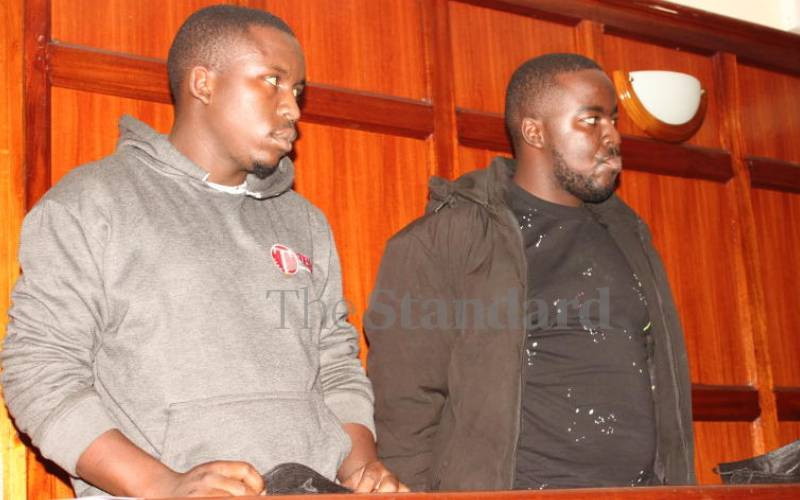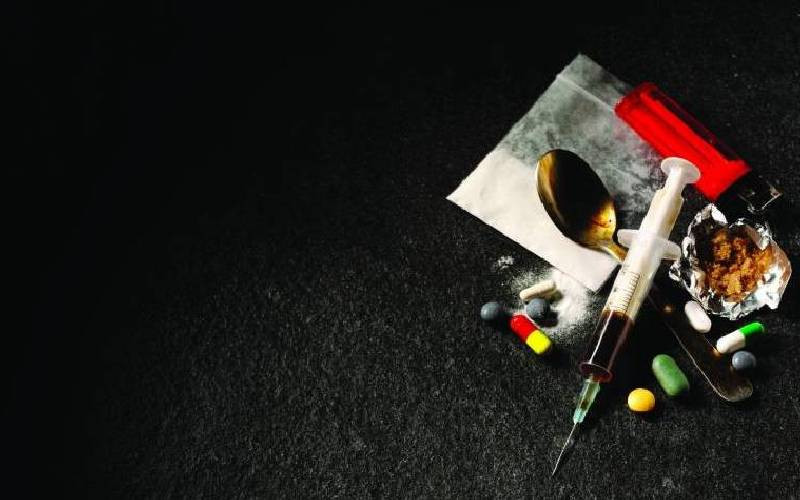By Kenan Miruka and Nick Oluoch
Despite intensified crackdowns on bhang traffickers in Kenya, dealers are increasingly becoming smarter at eluding police dragnets as they continue to profit from the trade.
Police estimates indicate that a large per cent of the bhang seized in the country each year originates from Tanzania and is brought through the Sirare border point.
CCI investigation established most of the bhang is grown in sugarcane farms and also interspersed with maize and other food crops in Tarime District to the North West of Tanzania before finding its way into the Kenyan market. |
Migori deputy OCPD Kiplang’at Korir in his office. He says security officers in Tanzania appear to condone bhang growing in the country. [PHOTOs: kenan miruka/Standard] |
Some Kenyan small-scale farmers and drug barons are believe
d to own bhang farms in Northern Tanzania.
Owing to the close cultural ties between communities living along the border, law enforcers find it difficult to control the vice.
ingenious style
Traffickers have also come up with ingenious ways of packaging the narcotic drug before transporting it to Nairobi and Mombasa.
So much is the bhang nabbed in the region that Kuria West DC James Mugwe notes that the stores where bhang confiscated by security officers are kept are already full. He notes they might have to start burning some to create space for more.
"There is simply no room for any extra bhang. Despite our efforts to stop the vice along the border, the illegal traders seem determined to carry on," says Mr Mugwe. Migori deputy OCPD Kiplang’at Korir says 12 cars including two top of the range GK vehicles are being held at Migori and Rongo police stations over the illegal trade.
He notes that over 45,000 stones of bhang have been impounded in the last one year in Migori area alone.
"We are winning the war. Several suspects have been arrested and arraigned in court although nearly all are released on bail. These days, the traffickers have changed the route to Ntimaru-Kilgoris-Keroka en-route to Nairobi and other towns," says Korir.
Stay informed. Subscribe to our newsletter
The officer says bhang grown in the Northern parts of Tanzania matures around December and January and that is the time when the business is at its peak.
"The haul is shipped into Kenya in small quantities in broom form before being packed into stones in Kenya. Some use boda bodas and bicycles to transport it.
They even have lead cars that check on police roadblocks before the vehicles carrying the drug pass," adds Korir.
The officer cites lax enforcement of the anti-narcotics law in Tanzania as the cause of the problem.
"Bhang growing and selling is not legal in Tanzania per se, but security officers across the border seem to condone the vice as large farms thrive even with their knowledge," he says.
Korir says members of the public could help police with information. "Having road blocks is not enough. We need information to stamp out the vice," he adds.
He says some of the drug traffickers have been known to venture into other business like taxi and real estate to disguise their illegal trade.
Drug trade is one of the most profitable businesses with ready market in Nairobi and the Coast provinces.
Source market
One stone of bhang is believed to cost about Sh100 in the source market, but goes for Sh2,000 when it eventually reaches Mombasa, making the traffickers even more determined.
Kenya Revenue Authority Assistant Commissioner in charge of Isebania border point John Chengole says over the years, the traffickers have become more sophisticated in concealing the illegal trade.
"They used to ferry the bhang in public service vehicles," he said, adding that at the time it was easier to get them especially at the police roadblocks.
However, the traffickers now travel in top of the range cars making it hard for police to detect their illegal activities even at roadblocks.
Traffickers targeting state of the art vehicles for hire pose as business executives going on holiday. The vehicles they hire are later used to ferry the drugs to Nairobi.
early risers
According to Martin Otieno, a resident of Migori, the traffickers prefer to travel very early in the morning to minimise chances of the drug detection through its smell.
"Bhang smells a lot whenever it is exposed to heat and so it is important that it is transported before sunrise," says Mr Otieno, adding traffickers always leave at about 4am.
Traffickers
He says the traffickers travel with a lot of loose currency, which comes in handy whenever they are forced to part with bribes at police roadblocks.
Sources in the trafficking ring told CCI that most of the bhang is transported from Tanzania to Kenya through panya routes along the border by cyclists.
The cyclists are used to ferry the bhang haul in small quantities across the Sirare border through illegal entry points to avoid detection.
"Those behind the trade have been known to use many methods of concealment. The situation is complicated because our borders are porous and difficult to police," says a senior CID officer who previously worked with the anti-narcotics department.
In Kisii, cases of bhang trafficking have been on the rise with police intercepting millions worth of the drug along the Isebania-Kisii-Nairobi highway.
In July, police in Kisii impounded 2,430 stones of bhang valued at Sh1.2 million after a vehicle ferrying the haul was involved in an accident.
Kisii OCPD Peter Njenga said they suspected the bhang originated from neighbouring Tanzania and was being transported to Nairobi and Mombasa for sale.
The bhang was concealed in cement bags which bore Kenya Bureau of Standards tandardisation marks.
"Kisii is normally used as a transit point, but we have intensified patrols and surveillance to stop the illegal trade," says Mr Njenga.
Neatly packed
In April last year, police in Kisii impounded 30 bags each containing 500 neatly packed stones of bhang at Suneka market. The bhang was packed beneath sugarcane being transported in a lorry.
And in July 2008, a bhang haul worth Sh3 million was impounded in Kisii South District. The 5,939 stones of bhang were concealed in bags hidden beneath timber being ferried to Nairobi.
Migori based lawyer Edward Kisia who has handled many cases involving bhang trade blames police for laxity in dealing with the trade.
"Migori is a vast area and the Mara region of Northern Tanzania where bhang is grown is equally large. These regions are not well policed hence the thriving trade. Police stations are in towns like Musoma and Tarime, which favours traffickers," says Kisia.
He says only two border points of Kopana and Isebania are policed leaving the rest of the border without proper policing.
He advises that car hire firms should install car track devices and liaise with police to monitor the movement of vehicles.
police vigilance
Nyatike DC Patrick Mwangi notes cases of bhang trafficking in the region are reducing due to increased vigilance by police along the border.
He further attributes the decline in trafficking to opening of new police posts along the border like Otho near Muhuru Bay, which has been notorious for trafficking bhang.
"Over the last two months, only one major case was reported in which a motor vehicle ferrying a bhang haul was intercepted at Namba Kodero in Nyatike. The vehicle rolled after attempting to evade a police dragnet. The occupant was arrested," he says.
The DC noted that there was cooperation between Kenyan and Tanzania authorities in combating the vice.
"Last month, we held a joint meeting of Kenyan and Tanzania DOs at the border where a joint strategy on combating the crime was discussed," Mwangi says.
 The Standard Group Plc is a
multi-media organization with investments in media platforms spanning newspaper
print operations, television, radio broadcasting, digital and online services. The
Standard Group is recognized as a leading multi-media house in Kenya with a key
influence in matters of national and international interest.
The Standard Group Plc is a
multi-media organization with investments in media platforms spanning newspaper
print operations, television, radio broadcasting, digital and online services. The
Standard Group is recognized as a leading multi-media house in Kenya with a key
influence in matters of national and international interest.
 The Standard Group Plc is a
multi-media organization with investments in media platforms spanning newspaper
print operations, television, radio broadcasting, digital and online services. The
Standard Group is recognized as a leading multi-media house in Kenya with a key
influence in matters of national and international interest.
The Standard Group Plc is a
multi-media organization with investments in media platforms spanning newspaper
print operations, television, radio broadcasting, digital and online services. The
Standard Group is recognized as a leading multi-media house in Kenya with a key
influence in matters of national and international interest.









